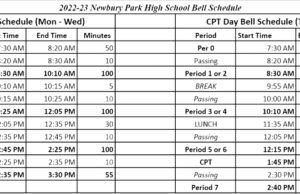We have these classes?
What do anthropology, comparative religions, sports medicine, and music theory all have in common? They are all classes that are offered at NPHS! Though small, these little-known classes offer unique opportunities and learning experiences.
Anthropology and Comparative Religions
Anthropology and Comparative Religions are two quarter block academic electives taught at the CP level by Richard Bradley, social studies teacher. Anthropology focuses on the history of humanity, starting with the the discovery of Lucy, the oldest human fossil found. It explores the topic of how government and cultures were formed around the world. From there, students learn about the formation of societies, use of tools, human interaction, and the sciences people used in the past. Comparative Religions focuses on the five largest religions of the world: Christianity, Islam, Buddhism, Judaism, and Hinduism. The class teaches the basics of each religion – who, when, and how followers of each faith worship. As a supplemental learning source, a guest speaker is invited to speak to the class about each religion, which “enables students to interact with experts,” according to Bradley.
So, why might a student be interested in Anthropology and Comparative Religions? Harrison Anderson, senior, who took the two classes as a junior, said that “learning about other religions really makes you a more well rounded person, you really come to respect a lot of other people’s religions and culture.”
Anderson has integrated this understanding into his everyday life and conversations and revealed many misconceptions. For example, he said that in America, there is an association between Islam and terrorism, but that he learned that the word “jihad” isn’t even used in the Quran. Anthropology, Bradley explained, can also be used to better understand today’s world and the culture wars that are currently present in the United States.
“You can’t believe (anything or everything) you hear, and only half of what you see,” Bradley said. “And by examining (these things) it helps (you to) understand. This doesn’t mean you have to sacrifice your own faith or compromise your own faith, but at least understand where others are coming from. Because in the United States especially, living in a society of religious freedom, I think that’s an important thing to understand – where other religious denominations are coming from.”
“I would recommend that people take this class,” Anderson said. “It’s a great class and Mr. Bradley is a great teacher for it, and I think if anything, even if you don’t need the credits … (it will) teach you more about the world.”
Sports Medicine
In Sports Medicine, a class taught by Lorena Caufield, students learn about taping, assessing injuries, and basic anatomy. Created in 2007, the Sports Medicine/Athletic Training Program has since become a UC-approved lab science course.
Students can apply what they learn in Sports Medicine, a regular class, during period five Athletic Training. Riley Vezina, senior, has taken both Sports Medicine and Athletic Training, and says that while most students who take one of the classes usually take the other as well, she recommends taking Sports Medicine first. “Sports Medicine is general anatomy. The after-school course, (Athletic Training), is where you get assigned to a sports team and you go further with the sports medicine … you use the stuff you use in Sports Medicine on players in Athletic Training,” Vezina said.
Both junior Erich Wuesthoff and Vezina agree on their favorite element of the class. “You can take it at your own pace, you’re not pressured to learn anything too quickly and learn it incorrectly,” Wuesthoff said, giving the example of taping tests. “You can take (them) as many times as you want or until you get the grade you want, so you’re actually learning rather than just getting a grade on something, then moving onto something else,” he said.
“I would agree with Eric,” Vezina said. “I like the pace of the class. I like how (Caufield) doesn’t force into moving on when you don’t completely understand something.”
As a prerequisite, most students have to take anatomy to get into the class. Furthermore, the class is mostly juniors and seniors, with a few sophomores. Wuesthoff recommends the class to athletes, because “you get to learn about what’s happening to you on the field.”
Vezina is using her knowledge differently. “I want to learn more about how I can help athletes because I want to go into a field where I’m working with athletes one-on-one, and this is a great experience,” Vezina said. “It will help later on when I go into school.”



